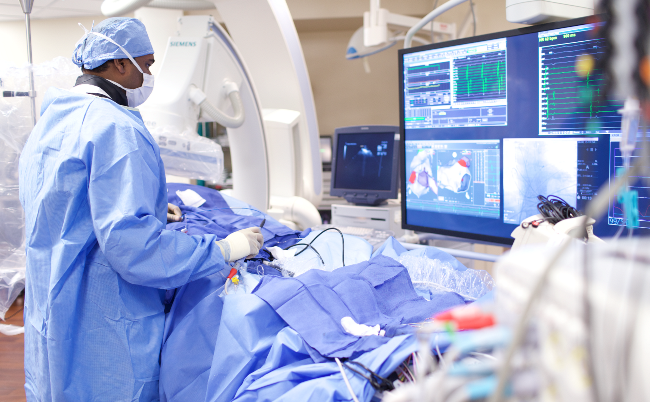Usually a heart beats at just the right tempo. But sometimes it can beat too fast, too slow or simply out of rhythm — a condition called arrhythmia.
How much do you know about arrhythmia? Read on as Harish Manyam, M.D., director of cardiovascular research and director of the Atrial Fibrillation Center at UT Erlanger Health, answers some common questions.
Q: What exactly is an arrhythmia?
An arrhythmia occurs when the heart’s electrical impulses, or beats, happen too fast, too slow or erratically. Anytime the heart doesn’t beat normally, it also can’t pump blood through the body effectively, which means the body’s organs can’t work properly.
“An arrhythmia is basically an abnormal rhythm of the heart,” Dr. Manyam said. “People with an arrhythmia usually experience some combination of a racing heart, lightheadedness, dizziness, chest pain and shortness of breath.”
Q: What are the most common types of arrhythmia?
The type of arrhythmia is categorized by where in the heart it occurs. The heart has four chambers — two upper chambers called the atria and two lower chambers called ventricles.
“Atrial fibrillation is the most common type of arrhythmia,” Dr. Manyam said. “It’s an abnormality of the left atrium in the top chamber of the heart. Atrial fibrillation is most associated with increased age, but the condition has lots of triggers, including swallowing, exercise, caffeine and alcohol. Those are all triggers but not necessarily causes. Atrial fibrillation is very concerning because it can affect the heart muscle and is linked with stroke.”
Watch this brief video to learn about atrial fibrillation and its symptoms.
In the lower chambers of the heart, ventricular fibrillation can occur.
“Ventricular fibrillation happens in people with weak heart muscles and can be associated with sudden cardiac death,” Dr. Manyam said. “If we suspect ventricular fibrillation, we conduct exams to evaluate heart function, and then typically put a defibrillator in to restore a normal heart rhythm.”
Other types of arrhythmia include:
- Bradycardia, which is a slow heart rate
- Conduction disorders, where the heart doesn’t beat normally
- Premature contraction, where the heart beats early
- Tachycardia, which is a very fast heart beat
Q: How are arrhythmias treated?
The type of treatment varies by the type of arrhythmia. Many arrhythmias are considered harmless and simply carefully observed. If the arrhythmia is diagnosed as clinically significant, your doctor will formulate a treatment plan.
“Atrial fibrillation can be treated in multiple ways,” Dr. Manyam said. “Anticoagulants [blood thinners], antiarrhythmic medications, and ablation, a procedure that restores a normal heartbeat, are all treatment options.”
With ventricular fibrillation, as mentioned above, treatment typically involves the implantation of a defibrillator but may also include ablation to restore a normal heart rhythm.
Q: Is it possible to reduce your risk?
Healthy lifestyle habits can help prevent arrhythmia and other heart-related conditions. For a heart-healthy lifestyle:
- Maintain a normal blood pressure level (less than 120/80 mmHg).
- Aim for the recommended total cholesterol level (less than 180 mg/dL).
- Eat a healthy diet filled with fresh fruits and vegetables.
- Avoid excess sodium and sugar.
- Exercise for at least 30 minutes on at least five days of the week.
- Don’t smoke.
“The important thing to know is that once you experience an arrhythmia, good lifestyle habits aren’t going to change the fact that you have it,” Dr. Manyam said. “If you experience symptoms, don’t ignore them — seek medical attention.”







